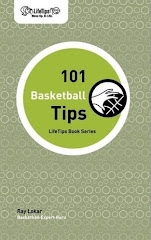Here are a few thoughts that might make the use of Player Notebooks and Playbooks most effective. I've used them some years and some years we didn't. Not really sure why. Sometimes it can become a chore to police their use at first. But if you feel strongly enough that their use will be effective - it may be worth it.
Having one place to store schedules, tournament brackets, workout schedules, charts, or the players meetings and appointments is simply a good organizational skill that you are teaching your players that may carry on later in life. There were plenty of times we need to bring our Faculty Handbook to meetings or they may be in a business meeting where they must show up with their Operations Manual. And if they do play at the next level, they may very well be expected to take care of their playbook. They already take notebooks and text books to their classes - basketball is our class and it is not unreasonable to think that they can be responsible to do the same.
We had a pretty good football program and as hard as I found it at first, I tried to take the lead from them and emulate them a bit. If they can keep track of and demand the use of playbooks in HS - why couldn't we? I took the same approach to watching film, team or position meetings, conditioning/strength training and even more importantly the precision, timing and execution of our offense. Imagine what happens if linemen don't execute blocking schemes, quarterbacks and running backs don't time handoffs, backs don't hit holes at the right time, or the receiver doesn't break when the quarterback is ready to deliver the pass on a timing route!?! While teams can't get players to set and use screens properly? Shoot, the band and drill team moves at halftime are more coordinated than many basketball teams offenses. In an Olympic year we won't even talk about synchronized swimming! In a pool? Underwater? And point guards aren't ready to deliver passes when players break open.
But I digress....as usual!
I guess what I'm thinking is that you get what you emphasize, reward and are willing to demand. When we began to demand the same level of discipline and commitment as our football team we began to be taken more seriously and less as something to do between football and spring football.
One year I stapled our "playbook" together and found one on the floor of an opponents locker room after a game. The next year I put them in 3-prong portfolios and things weren't much better. A good 3-ring binder or even a "Trapper Keepr" style may be even more effective. So the better the quality - the more they may respect it.
Our league away games were anywhere from 45 minutes to 1:30 away, so we wanted them to be able to review the books and scouting reports on the bus. Are you willing to make the notebook their bus ticket? You'll only need to leave someone behind once to solve that problem.
When you have a team meeting, have them show you the book upon entering. If they don't have it - send them away. If you have consequences for missing a team meeting, those consequences would kick in. Again, that might happen once - or twice. But are you willing to enforce that? You get what you are willing to demand.
Maybe you're a team that uses targeted symbolic rewards to motivate. Stickers for assists, rebounds, points, steals, loose balls, wins, etc. They could get a sticker, when they show up with their book. Some coaches think that's a little juvenile - but I see a bunch of "paw prints", "tomahawks", and "buckeye leaves" on helmets every New Years Day! Another concern is where do you display those stickers. On posters in the locker room? In the gym? Well, maybe you can put them on the back of the 3-ring binder that houses your playbook. Then it becomes a badge-of-honor. Do you think kids might take care of it better and maybe even carry it around to "display" their success?
From a practical standpoint, seasons that I was really committed to using the books we'd give out the page(s) of the play that we were going to put in at practice tommorrow and players were responsible to study and be prepared the next day. When tomorrow arrives have them walk through it. In a matter of just a couple of minutes, you are now working 3/4 speed and discussing KEY components of execution such as timing, floor spacing and the sequence of options. We might have saved 5-15 minutes for each play/set we put in. Add that up over the course of a year.
GET READY FOR GAME 7
-
The Indiana Pacers avoided an end to their season beating the New York
Knicks Friday night in Indy, 116-103. The series is tied 3-3. Game 7 is
Sunday, 3:30...
6 hours ago









